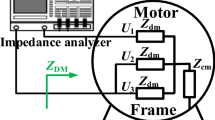Abstract
Switching energy in electrical vehicles can create serious noise from the motors. However, the characteristics of switching noise in vehicle motors are not clear due to the complexity of measuring them. This study proposes a new experimental method to investigate the switching noise energy of a vehicle motor based on frequency response functions. A function generator-amplifier system is used to generate the switching energy instead of the complex battery-inverter system that has previously been used to examine the noise energy characteristics. Even though newly adapted experimental method is simple, the switching noise energy was explicitly investigated under various input signals. Thus, this simple new method can be used to investigate the dynamic characteristics of noise energy in a vehicle motor.
Similar content being viewed by others
References
P. Vijayraghavan and R. Krishnan, Noise in electric machines: A review, IEEE Transactions on Industry Applications, 35 (1999) 1007–1013.
G. H. Lee, W. C. Choi, S. I. Kim, S. O. Kwon and J. P. Hong, Torque ripple minimization control of permanent magnet synchronous motors for EPS applications, International Journal of Automotive Technology, 12 (2011) 291–297.
T. M. Jahns and W. L. Soong, Pulsating torque minimization techniques for permanent magnet AC motor drives -A review, IEEE Transactions on Industrial Electronics, 43 (1996) 321–330.
L. Parsa and L. Hao, Interior permanent magnet motors with reduced torque pulsation, IEEE Transactions on Industyial Electronics, 55 (2008) 602–609.
R. Islam, L. Husain, A. Fardoun and K. McLaughlin, Permanent-magnet synchronous motor magnet designs with skewing for torque ripple and cogging torque reduction, IEEE Transactions on Industry Application, 45 (2009) 152–160.
D. Hanselman, Minmum torque ripple, maimum efficiency excitation of brushless permanent magnet motors, IEEE Transaction on Industrial Electronics, 41 (1994) 292–300.
H. Zeroug, B. Boukais and H. Sahraoui, Analysis of torque ripple in a BDCM, IEEE Transaction on Magnetics, 38 (2002) 1293–1296.
L. Zhu, S. Z. Jiang, Z. Q. Zhu and C. C. Chan, Analytical methods for minimizing cogging torque in permanentmagnet machines, IEEE Transactions on Magnetics, 45 (2009) 2023–2031.
K. Atallah, J. Wang and D. Howe, Torque-ripple minimization in modular permanent-magnet brushless machines, IEEE Transactions on Industry Applications, 39 (2003) 1689–1695.
E. Favre, L. Cardoletti and M. Jufer, Permanent-magnet synchronous motors: A comprehensive approach to cogging torque suppresion, IEEE Transactions on Industry Applications, 29 (1993) 1141–1149.
C. A. Borghi, D. Casadei, A. Cristofolini, M. Fabbri and G. Serra, Minimizing torque ripple in permanent magnet synchronous motors with polymer-bonded magnets, IEEE Transactions on Magnetics, 38 (2002) 1371–1377.
C.-Y. Hsiao, S. N. Yeh and J. C. Hwang, A novel cogging torque simulation method for permanent-magnet synchronous machines, Energies, 4 (2011) 2166–2179.
X. Liu, Z. Gu and J. Zhao, Torque ripple reduction of a novel modular arc-linear flux-switching permanent-magnet motor with rotor step skewing, Energies, 9 (2016) 1–17.
J. K. Steinke, Use of an LC filter to achieve a motorfriendly performance of the PWM voltage source inverter, IEEE Transactions on Energy Conversion, 14 (1999) 649–655.
P. A. Dahono, An LC filter design method for single-phase PWM inverters, Proceedings of 1995 International Conference on Power Electronics and Drive Systems, 2 (1995) 571–576.
V. Dzhankhotov and J. Pyrhönen, Passive LC filter design considerations for motor applications, IEEE Transactions on Industrial Electronics, 60 (2013) 4253–4259.
C. M. Liaw, Y. M. Lin, C. H. Wu and K. I. Hwu, Analysis, design, and implementation of a random frequency PWM inverter, IEEE Trans. on Power Electron, 15 (2000) 843–854.
R. L. Kirlin, M. M. Bech and A. M. Trzynadlowski, Analysis of power and power spectral density in PWM inverters with randomized switching frequency, IEEE Trans. on Ind. Electron, 49 (2002) 486–499.
G. Yinghua, G. Honglin, W. Xinhua and T. Jinfei, Study on soft switching technology to reduce electromagnetic interference of PWM inverter, Energy Procedia, 17 (2012) 384–390.
J. Loncarski, M. Leijon, M. Smdovic, C. Rossi and G. Grandi, Comparison of output current ripple in single and dual three-phase inverters for electric vehicle motor drives, Energies, 8 (2015) 3832–3848.
Author information
Authors and Affiliations
Corresponding author
Additional information
Recommended by Associate Editor Junhong Park
Hyunsu Kim, Ph.D. received his doctor degree at the Ohio State University in 2011 after achieving B.S. from Kookmin University in 2001 and M.S. from University of Cincinnati in 2006. His research area is acoustics of intake/ exhaust system especially focusing on nonlinear characteristics in silencers in the presence of flow. From 2011 to 2016, he worked at Hyundai-Kia Motor Company as a Senior Researcher in the power-train NVH team expanding his area of interest to (hybrid) electrical vehicle motor noise. He is currently CEO of Ensemble Center of Automotive Research.
Jong-Yun Yoon received his Ph.D. from the Department of Mechanical Engineering at the Ohio State University. He is currently an Assistant Professor at Incheon National University. His research interests are in automotive NVH, including nonlinear torsional vibration.
Rights and permissions
About this article
Cite this article
Kim, H., Yoon, JY. Frequency response function of motors for switching noise energy with a new experimental approach. J Mech Sci Technol 31, 2671–2677 (2017). https://doi.org/10.1007/s12206-017-0510-9
Received:
Revised:
Accepted:
Published:
Issue Date:
DOI: https://doi.org/10.1007/s12206-017-0510-9




